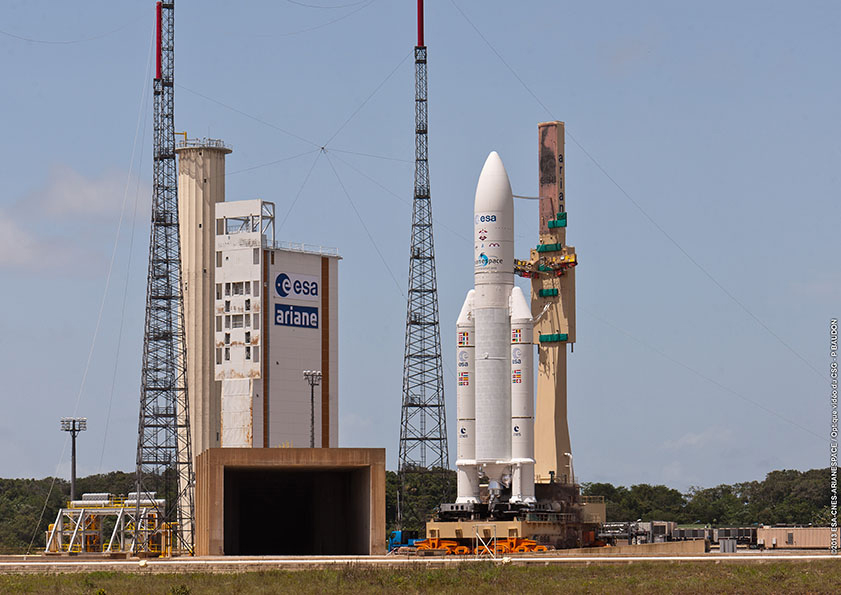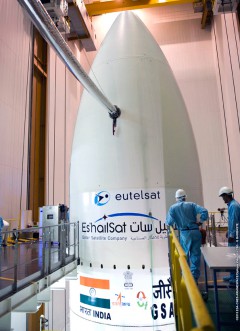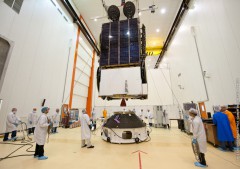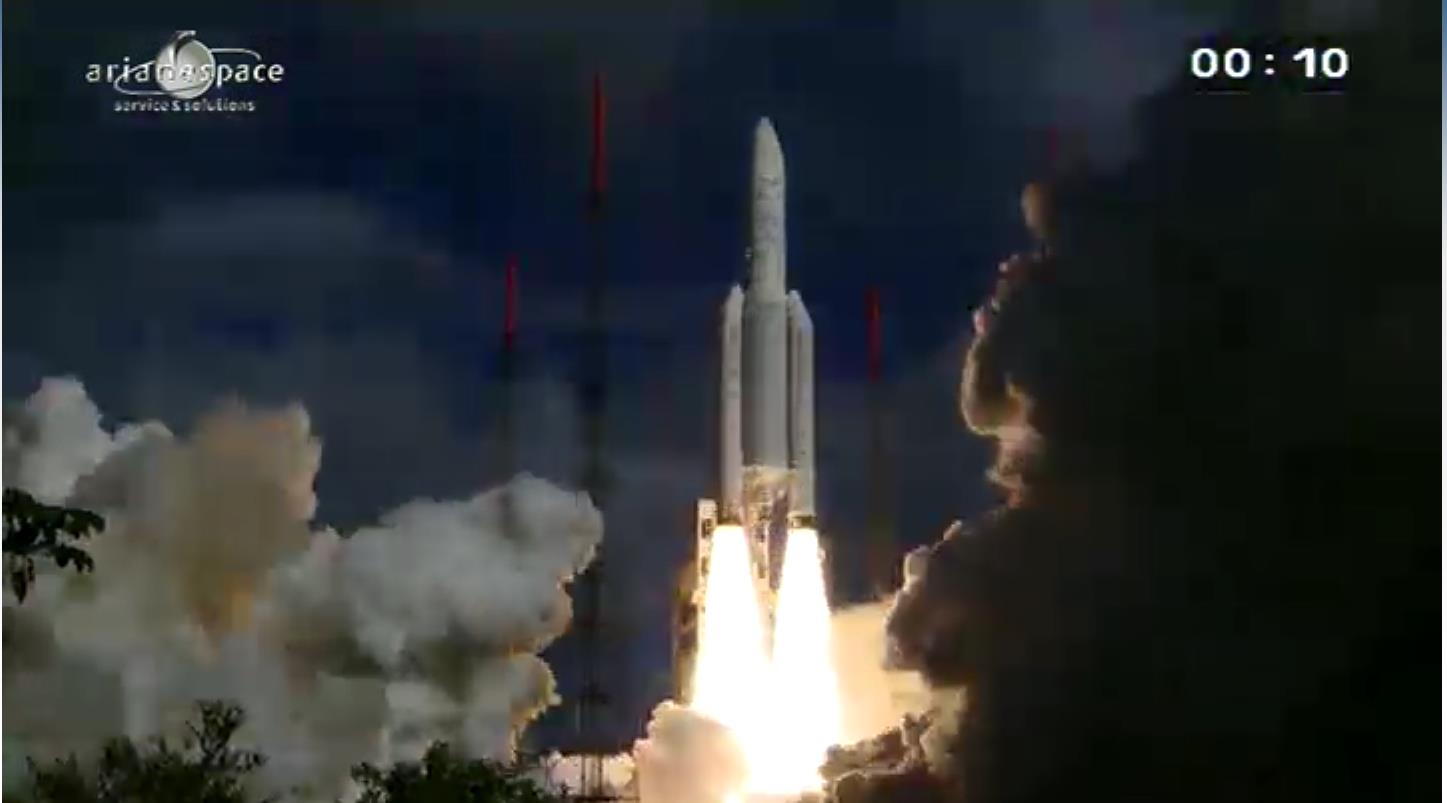
For the fourth time this year, Europe’s giant Ariane 5 booster stands primed and ready at the ELA-3 (Ensemble de Lancement Ariane) launch complex at the Guiana Space Centre in Kourou, French Guiana, tracking a liftoff on Thursday, 29 August with the Eutelsat 25B/Es’hail-1 and GSAT-7 communications satellites. According to Arianespace—the Paris, France-based launch services organization responsible for the development and operation of the vehicle—Mission VA-215 is targeted to get underway during a 50-minute “window” which extends from 5:30-6:20 p.m. local time (4:30-5:20 p.m. EDT). It will be the 71st launch of Ariane 5, which first flew back in June 1996, and the 215th mission by Arianespace’s rocket family since the maiden voyage of Ariane 1 in December 1979.
This year, 2013, has been a quite remarkable adventure for the venerable European booster. In February, an Ariane 5 lofted the Amazonas-3 and Azerspace-1/Africasat-1A payloads, followed by the Automated Transfer Vehicle (ATV)-4 “Albert Einstein,” toward the International Space Station in June and, most recently, the Alphasat and Insat-3D satellites last month. The VA-215 processing campaign has proceeded without incident at the South American facility, with the assembly of Ariane 5’s two stages and twin solid-fueled rocket boosters completed by 24 July in the Launcher Integration Building.

At about the same time, India’s GSAT-7 was deep into pre-flight checkout at Kourou “to confirm the multi-band satellite’s readiness with payloads in the UHF, S-band, C-band, and Ku-bands.” Developed by the Indian Space Research Organisation (ISRO) of Bangalore, southern India—whose attempt last week to test-launch its troubled Geostationary Satellite Launch Vehicle (GSLV) was scrubbed at T-2 hours—the 5,600-pound GSAT-7 arrived in French Guiana on 11 July and will spend nine years in geostationary orbit at 74 degrees East longitude. Also known as “Insat-4F,” it is a multi-band communications satellite, with a key aim to improve the coverage of telecom and direct-to-home broadcast services across the Indian subcontinent. GSAT-7 is also expected to support Indian defence forces, specifically the Indian Navy.
Also aboard Ariane 5 for the VA-215 mission will be Eutelsat 25B/Es’hail-1, built by Space Systems Loral of Palo Alto, Calif., for the French-led European Telecommunications Satellite Organisation (EUTELSAT) and Es’hailSat, the Qatar Satellite Company. According to EUTELSAT, the 13,200-pound satellite is expected “to respond to demand for the fastest-growing applications in the Middle East and North Africa, including video broadcasting, enterprise communications, and government services.” Eutelsat 25B/Es’hail-1 is equipped with four steerable, spot-beam antennas and four deployable reflectors, together with advanced command and telemetry capabilities, and is expected to support a 15-year operational lifespan in geostationary orbit. So named because it will reside at an operational location of 25.5 degrees East longitude, the satellite will cover North Africa, the Middle East, and Central Asia. It arrived at Kourou on 27 July for final processing.
Eutelsat occupies the upper segment of the Ariane 5’s SYLDA (Système de Lancement Double Ariane) payload dispenser, with GSAT-7 sitting “beneath” it in the dual-satellite “stack.” On 9 August, the Ariane 5 was transferred from the 190-foot-tall Launcher Integration Building (BIL) to the 295-foot-tall Final Assembly Building (BAF), a move which marked the formal hand-over of the vehicle from prime industrial contractor Astrium Space Transportation to Arianespace. Concurrently, Eutelsat was moved to the S5 payload preparation center for fueling. A week later, on 16 August, GSAT-7 was installed in the lower deck of the SYLDA. Eutelsat took its place in the upper deck on 19 August. Final flight readiness reviews took place yesterday (Tuesday), ahead of the scheduled rollout of the VA-215 stack to the ELA-3 launch zone on Wednesday, 28 August.
Rollout is expected to require about 40 minutes, and upon arrival at ELA-3 engineers will set to work establishing electrical, fluid, and other connections. Early on Thursday, final launch preparations will shift into high gear, with weather checks and authorization to begin loading 260,000 pounds of liquid oxygen and 50,000 pounds of liquid hydrogen into Ariane 5’s 100-foot-tall “cryotechnic main stage.” These propellants will feed the booster’s French-built Vulcain-2 main engine.

At T-4 minutes, the propellant tanks will be pressurized for flight and Ariane will be transferred to its internal power supplies. In the final seconds of the countdown, systems aboard the 171-foot-tall rocket will assume primary control of all critical functions and the guidance system will be unlocked to Flight Mode. Assuming a smooth countdown, VA-215 is targeting a launch at the opening of the 50-minute “window” at 5:30 p.m. local time (4:30 p.m. EDT) Thursday. Although the Vulcain will roar to life at T-0, liftoff itself will not occur for another 7.5 seconds, as a series of computer-executed engine-check operations will be conducted, ahead of the command to fire the side-mounted solid boosters. With the Vulcain generating 300,000 pounds of thrust, and each of the boosters pumping out an additional 1.4 million pounds, Ariane 5 will spear away from ELA-3.
For the first five seconds of the ascent, the rocket will rise vertically, after which the two computers inside the Vehicle Equipment Bay (VEB) will initiate a pitch and roll program maneuver, actively rotating Ariane towards the east and establishing it onto the proper flight azimuth to insert its twin satellite cargoes into orbit. A minute into the ascent, Ariane 5 will go supersonic and soon afterwards will pass through “Max Q,” the period of maximum aerodynamic stress on the airframe.
At T+142 seconds, the twin boosters will be jettisoned, heading for a parachute-assisted splashdown in the Atlantic Ocean, about 300 miles east of Kourou. Meanwhile, the rocket will by now have reached a velocity of 1,250 mph and will continue to climb under the impulse of the Vulcain engine. Three and a half minutes after liftoff, the bullet-like payload fairing will be jettisoned, exposing Eutelsat 25B/Es’hail-1 and GSAT-7 to the harsh space environment for the first time.

The Vulcain will shut down and the first stage will be discarded about nine minutes after launch, descending toward a splashdown zone off the coast of Africa, in the Gulf of Guinea. Meanwhile, the second stage—powered by a restartable, 6,100-pound-thrust Aestus engine—will ignite to pick up the baton for the final push into orbit. By now, the rocket will be over 105 miles high and traveling at more than 4,300 mph. Sixteen minutes later, having reached a velocity of 5,700 mph, Geostationary Transfer Orbit (GTO) will be attained. Eutelsat 25B/Es’hail-1 will depart the SYLDA at 27 minutes and 45 seconds after launch, followed by GSAT-7 at 34 minutes and 26 seconds.
Thursday’s mission will mark the 71st launch of an Ariane 5, which first flew back in June 1996. Weighing close to 1.7 million pounds, the rocket is one of the world’s most powerful launch vehicles and has supported dozens of missions, only four of which have been classified as total or partial failures. On its ill-fated maiden voyage, it succumbed to a software glitch and was remotely destroyed by the Flight Termination System when it began to veer off-course. Its second launch in October 1997 also failed, due to a premature shutdown of its core stage, whilst two others in July 2001 and December 2002 also underperformed. However, Ariane 5 has maintained unblemished record ever since. Key payloads delivered to space have included the Envisat environmental monitoring platform, the Artemis telecommunications satellite, the Rosetta cometary science mission, and four Automated Transfer Vehicles (ATVs) to the International Space Station.
Want to keep up-to-date with all things space? Be sure to “Like” AmericaSpace on Facebook and follow us on Twitter: @AmericaSpace
Missions » Commercial Space » EUTELSAT » EUTELSAT 25B »


